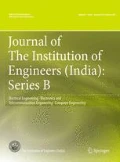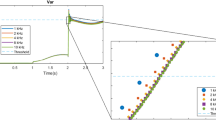Abstract
A method is proposed in this paper to detect and discriminate symmetrical fault during power swing. The method exploits the local end current information to perform the task. The algorithm will be executed in parallel with conventional distance relay algorithm. Negative and zero sequence components reveal the occurrence of unsymmetrical fault, but detection of symmetrical fault and its discrimination from other system balance phenomenon such as power swing is a difficult task. However, with the help of conventional MHO relay characteristics and proposed method which uses average rate of change of current (ARCC), detection of symmetrical fault and the exact discrimination from swing situation is possible. The average rate of change of current (ARCC) is used as a detection index in the proposed work. The proposed scheme is extensively tested on different power system models, and results are provided for different swing, fault, CT saturation and the presence of noise cases. The responses under power system stressed conditions are also investigated and discussed. The obtained results indicate that the suggested algorithm is able to maintain the balance between dependability and security aspects of the protection logic.













Similar content being viewed by others
References
P. Kundur, Power System Stability and Control (Tata McGraw-Hill, New York, 1994).
J.L. Blackburn, Protective Relaying: Principles and Applications (Marcel Dekker, New York, 1987).
G. Ziegler, Numerical Distance Protection Principles and Applications, 3rd edn. (Munich Publicist Corporate Publishing, Erlangen, Germany, 2008).
D.A. Tziouvaras, Relay performance during major system disturbances. In: IEEE 60th Annual Conference for Protective Relay Engineer, (2007), pp. 251–270
D.A. Tziouvaras, D. Hou, Out-of-step protection fundamentals. In IEEE 57th Annual Conference for Protective Relay Engineer, (2004), pp. 282–307
Power swing and out-of-step considerations on transmission line. (IEEE PSRC, 2005). https://www.ewh.ieee.org/r6/san_francisco/pes/pes_pdf/OutOfStep/PowerSwingOOS.pdf
B. Su, X.Z. Dong, Z.Q. Bo, Y.Z. Sun, B.R.J. Caunce, D. Tholomier, A. Apostolov, Fast detector of symmetrical fault during power swing for distance relay. In: IEEE Power Engineering Society General Meeting, (2005), pp. 1836–1841
B. Mahamedi, J.G. Zhu, A novel approach to detect symmetrical faults occurring during power swings by using frequency components of instantaneous three phase active power. IEEE Trans. Power. Deliv. 27(3), 1368–1376 (2012)
K.H. Karegar, B. Mohamedi, A new method for fault detection during power swing in distance protection. In IEEE 6th International conference on Electrical engineering/ Electronics, computer, Telecommunication and Information Technology, (ECTICON 2009), (2009), pp. 230–233
X. Lin, Y. Gao, Liu P, A novel scheme to identify symmetrical faults occurring during power swings. IEEE Trans. Power. Deliv. 23(1), 73–78 (2008)
J.G. Rao, A.K. Pradhan, Differential power-based symmetrical fault detection during power swing. IEEE Trans. Power. Deliv. 27(3), 1557–1564 (2012)
L. Xiangning, Z. Qing, L. Wenjun, W. Kecheng, W. Hanli, A fast unblocking scheme for distance protection to identify symmetrical fault occurring during power swings. In: 2006 IEEE Power Engineering Society General Meeting, (2006), pp. 1–8
W. Li, T. Bi, Q. Yang, Study on sequence component based fault phase selector during power swings. In: 5th International conference on Critical Infrastructure, (CRIS 2010), (2010), pp. 1–5
A.P. Apostolov, D. Tholomier, S.H. Richards, Superimposed components based sub-cycle protection of transmission lines. In IEEE Power Engineering Society, Power Systems Conference and Exposition, (PCSE 2004), (2004), pp. 592–597
H.K. Zadeh, Z. Li, A novel power swing blocking scheme using adaptive neuro-fuzzy inference system. Int. J. Elect. Power Syst. Res. 78(7), 1138–1146 (2008)
A. Swetapadma, A. Yadav, Data mining based fault during power swing identification in power transmission system. Int. J. IET. Sci. Meas. Tech. 10(2), 130–139 (2016)
J. Faiz, S. Lotfi-Fard, A novel wavelet based algorithm for discrimination of internal faults from magnetizing inrush currents in power transformer. IEEE Trans. Power. Deliv. 21(4), 1989–1996 (2006)
N. Zhang, M. Kezunovic, Transmission line boundary protection using wavelet transform and neural network. IEEE Trans. Power. Deliv. 22(2), 859–869 (2007)
S.M. Brahma, Distance relay with out-of-step blocking function using wavelet transform. IEEE Trans. Power. Deliv. 22(3), 1360–1366 (2007)
C. Pang, M. Kezunovic, Fast distance relay scheme for detecting symmetrical fault during power swing. IEEE Trans. Power. Deliv. 25(4), 2205–2212 (2010)
R. Dubey, S.R. Samantaray, Wavelet singular entropy based symmetrical fault detection and out of step protection during power swing. Int. J. IET. Gen. Trans. Dist. 7(10), 1123–1134 (2013)
A. Mukherjee, P.K. Kundu, A. Das, Transmission line faults in power system and the different algorithms for identification, classification and localization: a brief review of methods. J. Inst. Eng. India Ser. B (2021). https://doi.org/10.1007/s40031-020-00530-0
K. Seethalekshmi, S.N. Singh, S.C. Srivastava, A classification approach using support vector machines to prevent distance relay maloperation under power swing and voltage instability. IEEE Trans. Power Deliv. 27(3), 1124–1133 (2012)
J.G. Rao, A.K. Pradhan, Power swing detection using moving window averaging of current signals. IEEE Trans. Power. Deliv. 30(1), 368–376 (2015)
I.G. Tekdemir, B. Alboyaci, A novel approach for improvement of power swing blocking and deblocking functions in distance relays. IEEE Trans. Power. Deliv. 32(4), 1986–1994 (2017)
P. Kundu, A.K. Pradhan, Wide area measurement based protection support during power swing. Int. J. Electr. Power. Energy. Syst. 63, 546–554 (2014)
J. Khodaparast, M. Khederzadeh, Three-phase fault detection during power swing by transient monitor. IEEE Trans. Power. Deliv. 30(5), 2558–2565 (2015)
S. Lotfifard, J. Fiaz, M. Kezunovic, Detection of symmetrical faults by distance relays during power swings. IEEE Trans. Power. Deliv. 25(1), 81–87 (2010)
J. Mooney, Out-of-step protection fundamentals. In: IEEE 61th Annual Conference for Protective Relay Engineer, (2008), pp. 491–497
M. Biswal, Adaptive distance relay algorithm for double circuit line with series compensation. J. Meas. 53, 206–214 (2014)
Eastern Regional Power Committee (ERPC), Annual Reports, 2017 [Online]. Available: http://erpc.gov.in/wp-content/uploads/2018/06/Annual-Report-2017-18-1.pdf
Author information
Authors and Affiliations
Corresponding author
Additional information
Publisher's Note
Springer Nature remains neutral with regard to jurisdictional claims in published maps and institutional affiliations.
Rights and permissions
About this article
Cite this article
Andanapalli, K., Biswal, M. Symmetrical Fault-Swing Discrimination Algorithm for Transmission system. J. Inst. Eng. India Ser. B 102, 1033–1048 (2021). https://doi.org/10.1007/s40031-021-00578-6
Received:
Accepted:
Published:
Issue Date:
DOI: https://doi.org/10.1007/s40031-021-00578-6




